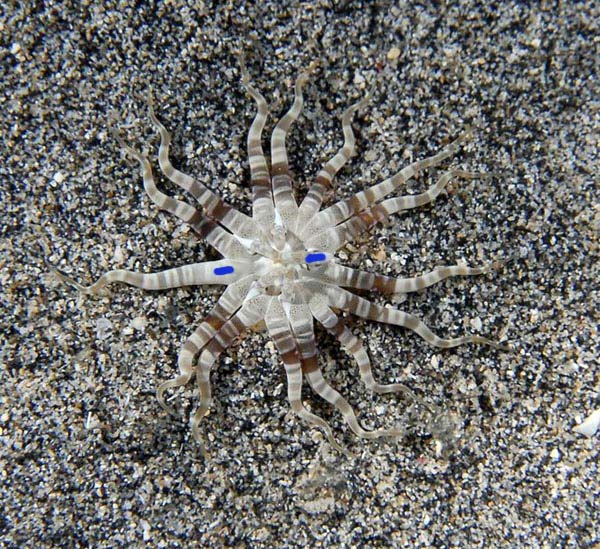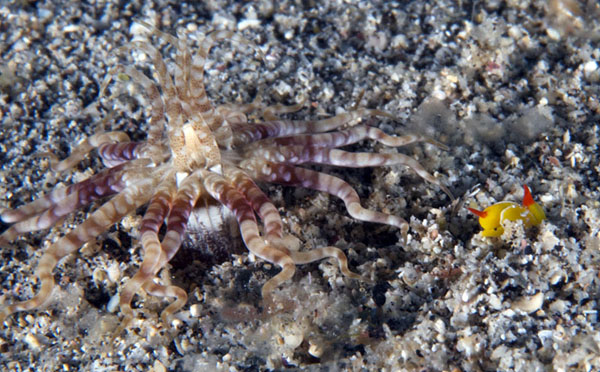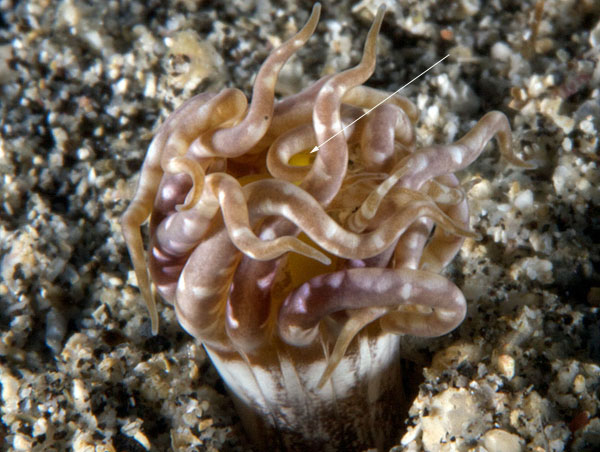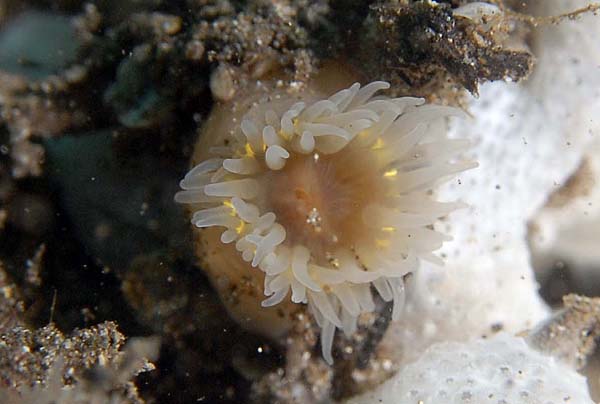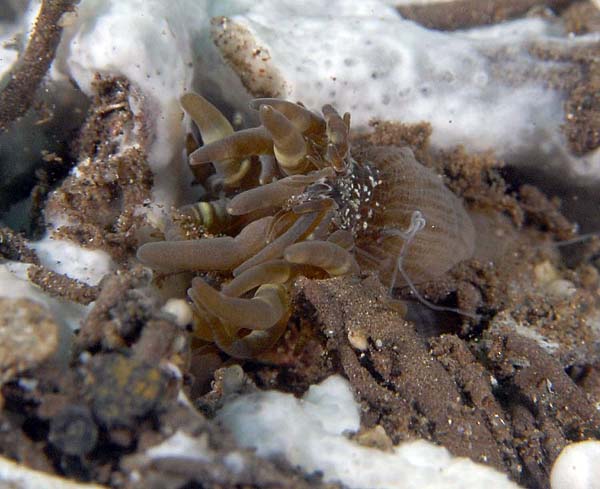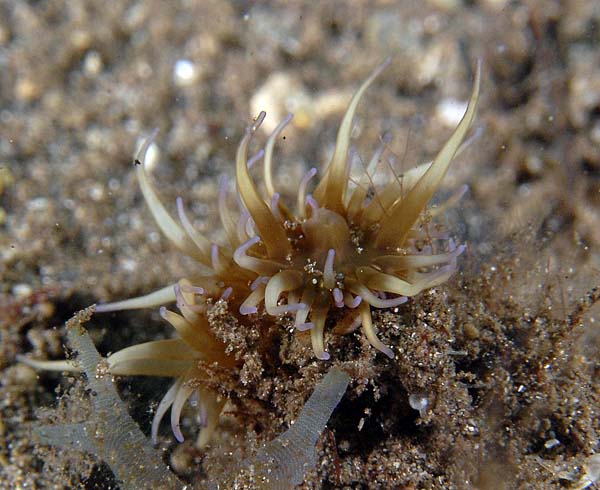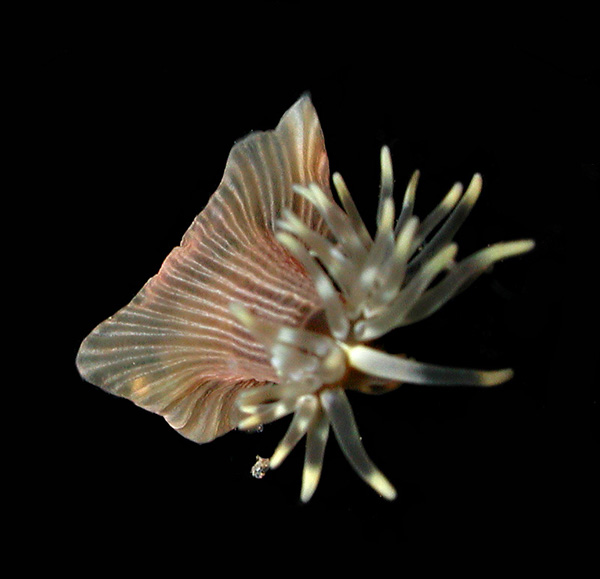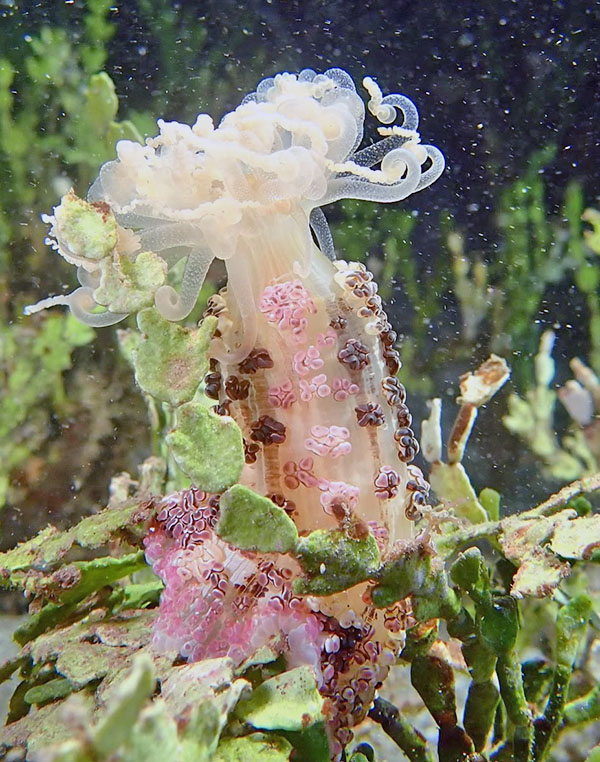|
hawaiisfishes.com
|
|
Home |
Fishes | Invertebrates |
Books | CDs
| Links |
Contact |
|
Some interesting sea anemones & zoanthids not in Hawaii's Sea Creatures The following
Bishop Museum list of Hawaii species is available online: |
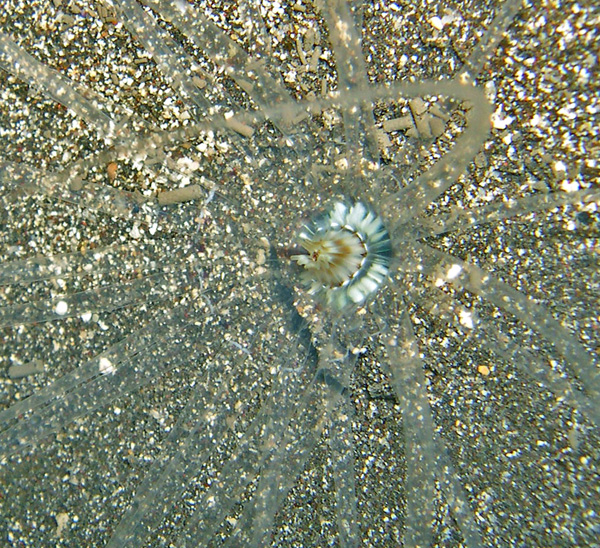 |
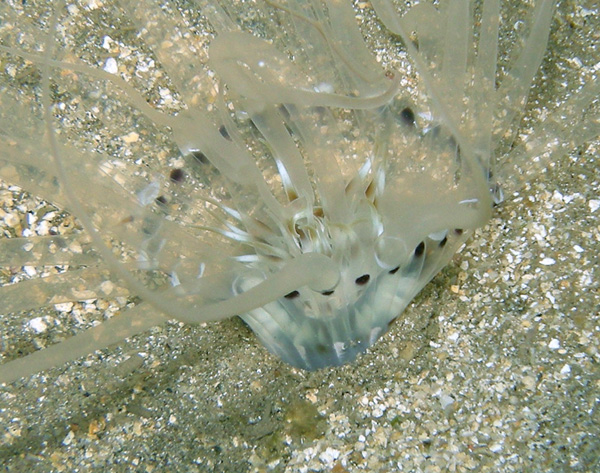 |
|
Ceriantharian 1 (possibly
genus Isarachnanthus) It lives in tide pools and, occasionally, in the shallow subtidal favoring sites with moderately high water movement. In tide pools, the tubes are anchored in sand-filled crevices. The disk diameter is usually around 20-30 mm and the tentacle length is 2-3 times the disk diameter. The body and marginal tentacles are transparent. There are superficial, basal brown spots on the outer faces of the marginal tentacles and narrow white collars above the spots. When photographed with a flash, it appears substantially more opaque than it does when viewed with the naked eye. By eye, looking down at a tide pool, the body and tentacles are glassily transparent and the white pigment is far less prominent (angle of view and light intensity effect the appearance). So, what you first notice is "a little ring of brown spots floating in mid-water." It's retraction response varies in speed from night to night, perhaps due to salinity or temperature changes in its pools. But, on a fast night it's extraordinary even for a ceriantharian--right at the limit of what can be perceived by the human eye. So, it "disappears" with barely a flicker. I doesn't retract when touched gently with an inorganic probe. But, at the slightest touch of a finger it's "gone." One time,when I was watching a pool with a line of them in the same crevice, I touched the one on the end triggering retraction. Without further disturbance, the next one in line retracted some second later, then the next one went after a few more seconds. And, that continued through the whole line of 5-6 animals. Presumably, they were responding to something diffusing through the water. I don't know whether I had an irritant on my hand or if retracting animals sometimes release a "signaling" compound... It extends its tentacles only at night and will sometimes also retract them if a flashlight beam is held on it too long. However, when responding to light, it retracts much more slowly than when responding to touch--just gradually folding them in. Like many anemones, they're fairly long-lived. I've been watching a couple of clusters in tide pools ever since 1986 with no evidence of significant changes through about 2015--I haven't been back for awhile...). And, there was one isolated subtidal animal near my "night float entrance" at Olowalu that I first noticed in 2000, last photographed in 2012 and last saw sometime around 2015. There was no appreciable change in size over that period. They appear to feed, primarily, by catching small planktonic animals with the marginal tentacles, then transferring them "one at a time" to the labial tentacles. The attached photos are all of the same individual taken at different times and at different angles. The first is of the whole animal taken at a slight angle. The second is a closeup of the disk cropped from that shot. They illustrate prey transfer. The third was taken looking straight down and illustrates how the markings change in appearance with the viewing angle. The fourth is a side view. All the photos are mine and were taken at Olowalu. Joe Rowlett lists it as an undescribed Isarachnanthus in his new book, Indo-Pacific Corals. He also says it can reproduce by transverse fission (with a photo illustrating the process) and has a photo of one that's taken a small fish indicating that it may occasionally eat larger prey.
|
|
Ceriantharian 2
(possibly genus Arachnanthus) The tentacles remain extended during the day. However, it's inconspicuous due to its small size. The disk diameter is only 2-4 mm with tentacle lengths of about twice the disk diameter. The marginal tentacles have alternating patches of brown and superficial-white pigment confined to their upper surfaces (unlike in the larger Isarachnanthus bandanensis in which the tentacles have complete brown rings on a cream background). There's dark-brown pigment between the bases of the marginal tentacles. Joe Rowlett
suggested that it's an Arachnanthus in e-mails and on i-Naturalist. |
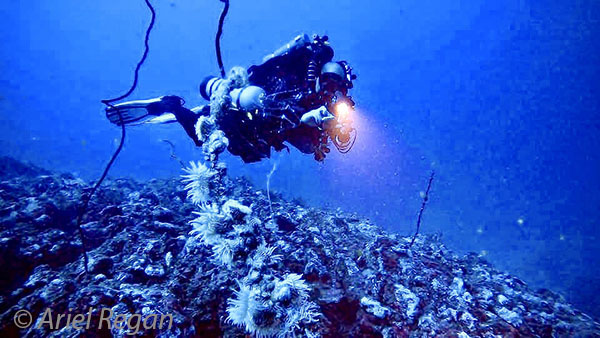 |
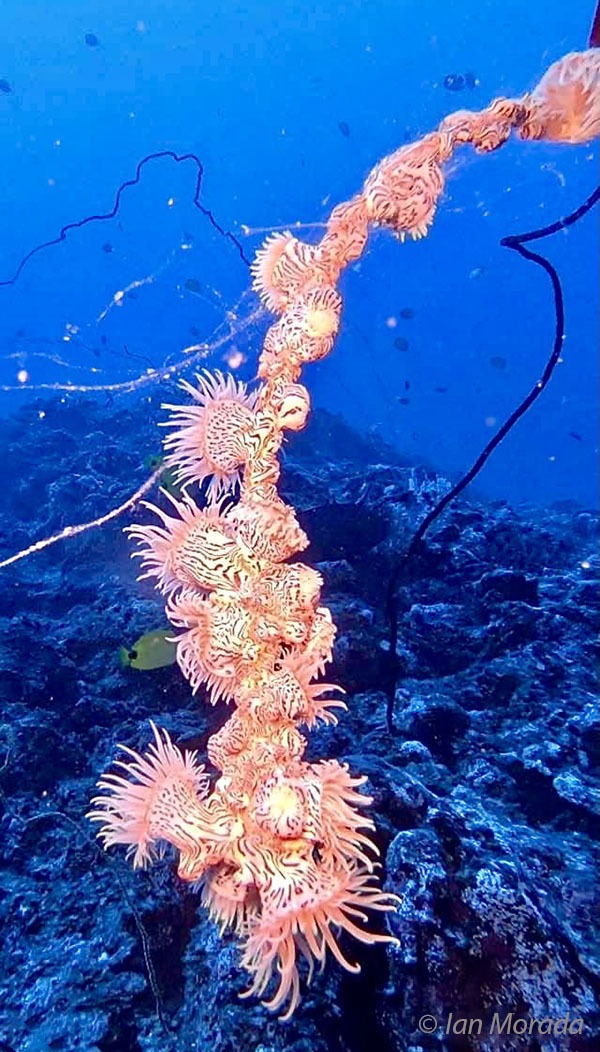 |
| "Tiger
Anemones" genus Nemanthes? Jason Crowder sent me these photos taken by his dive buddies Ariel Regan and Ian Morada at a depth of about 180 ft. off Kaneohe, Oahu. Jason calls them "Tiger Anemones"--as good a name as any in my opinion. Ariel reports that a portion of the wall at this site is covered with them. Those in the photo, however, have colonized a dead whip coral. Anemones in this genus often colonize long thin objects that stretch out into the current. Presumably this guarantees them a steady supply of plankton to feed on. Scroll all the way down to the bottom of this page to see what may be another species in the same genus found on black coral at a depth of 140 ft.. Perhaps they are the same species. In any case, there is no "official" record of any anemones of this type from Hawai'i. ============================================================================= |
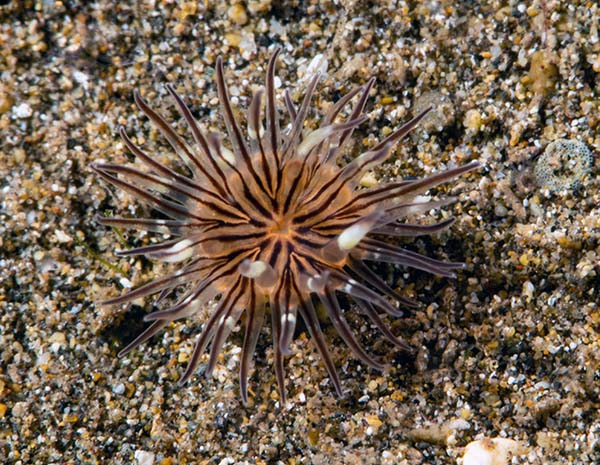 |
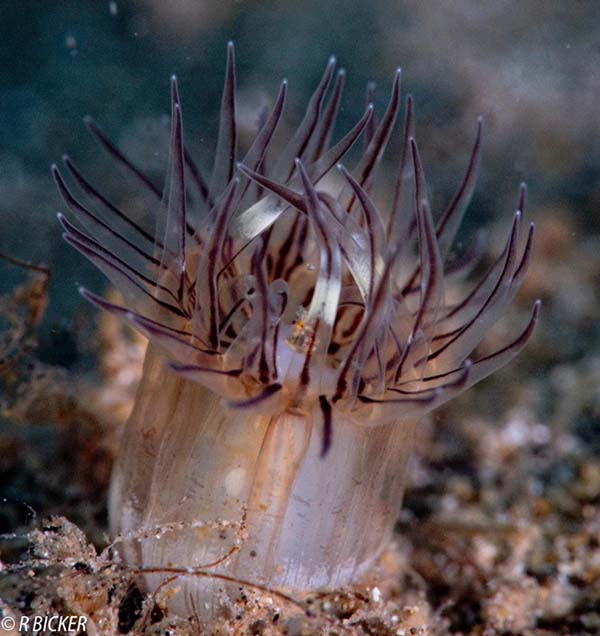 |
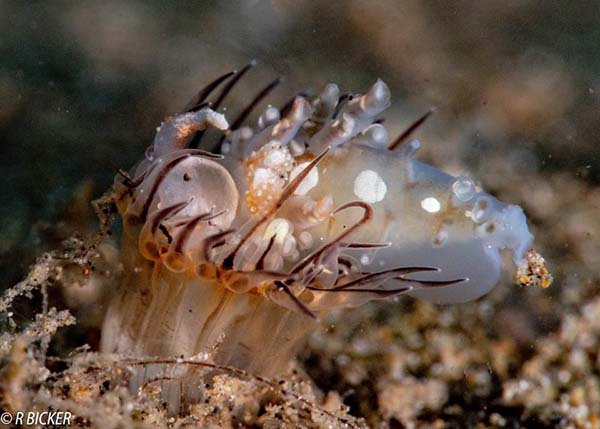 |
|
This unidentified
sand-dwelling anemone was photographed on July 26, 2021 in Maalaea
Bay, Maui. The top photo is by Kevin Roe and the bottom 2 photos
by Rebecca Bicker. All images were taken on the same dive, but the
bottom two images might not depict the same individual as the top
image. Rebecca has posted more photos of the nudibranch being eaten in the Sea Slugs of Hawaii Facebook group. ============================================================================= |
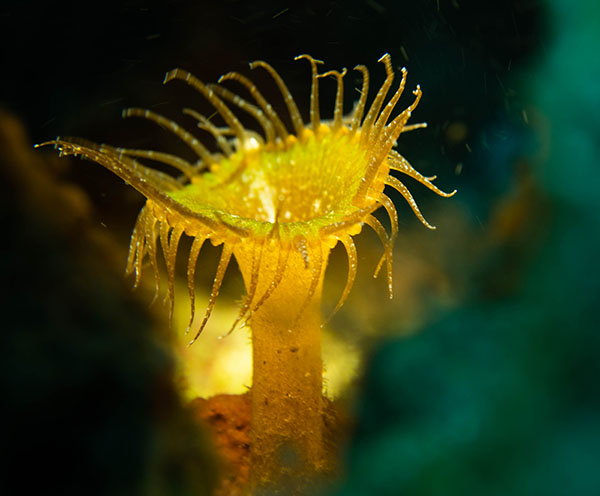 |
|
Palythoa sp. Mike Rudenko photographed this zoanthid at Crystal Cove (1/2 mile north of Kawaihae harbor, Big Island) in April 2019. He writes: "It was about 2" tall, found in a protected little puka in the satellite reef in the sand. Depth was 45 ft." I sent the photo to James Reimer, an expert on zoanthids, and he replied: Yes, this is Palythoa of some kind - and a nice image! The two rows or cycles of tentacles plus nice dorsal directive give it away. ============================================================================= |
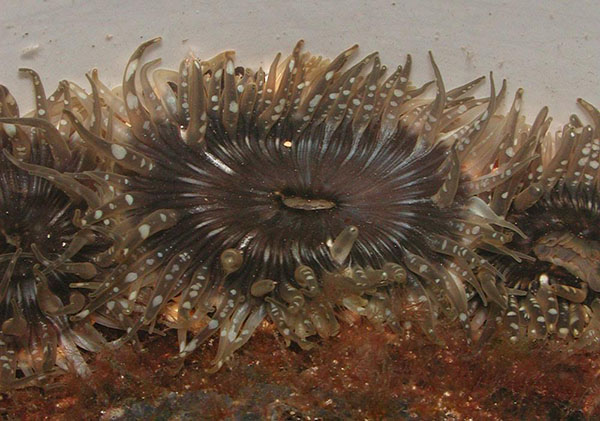 |
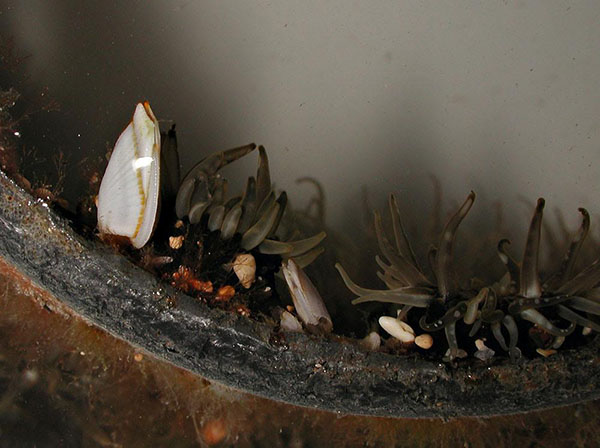 |
|
pelagic Anthopleura April 5, 2017 http://bodegahead.blogspot.com/2014/09/a-mouthful-for-moonglow.html That
one's supposed to be benthic. But, it may be "getting around"
on debris... The columns had a few grains of adherent sand (the
piece of plastic had become overloaded and sunk to the bottom though
it was still moving about in the surge). Also, another floating
piece with anemones was seen by others during the session. ============================================================================= |
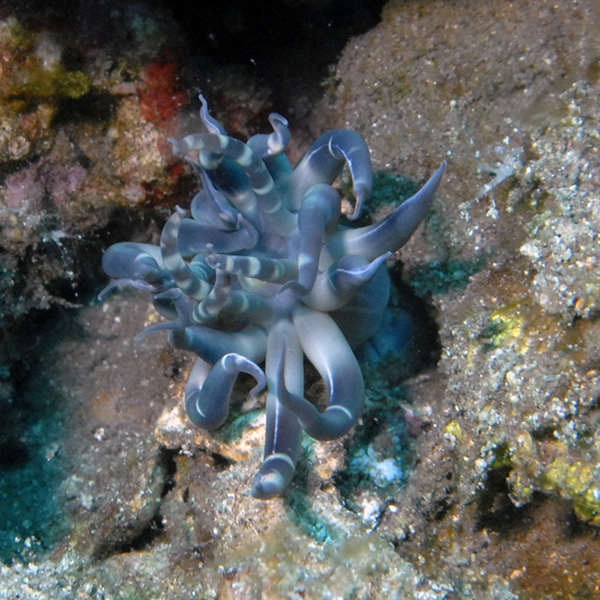 |
|
unknown edwardsid Divemaster Kelleen at Kohala Divers in Kawaihae noticed this unusual anemone at a depth of about 45 ft. in a fissure along at the base of a rocky wall. It was maybe an inch across. It retracted into a crack when touched, but opened again fairly soon. I sent this photo to Dr. Daphne Fautin who replied: "This is
likely to be another edwardsid. It is very much like dramatic animals
from Indonesia and environs ... What makes me think it is an edwardsid
is the size, the fact it is a burrower, its sensitivity, and the
number of tentacles." ============================================================================= |
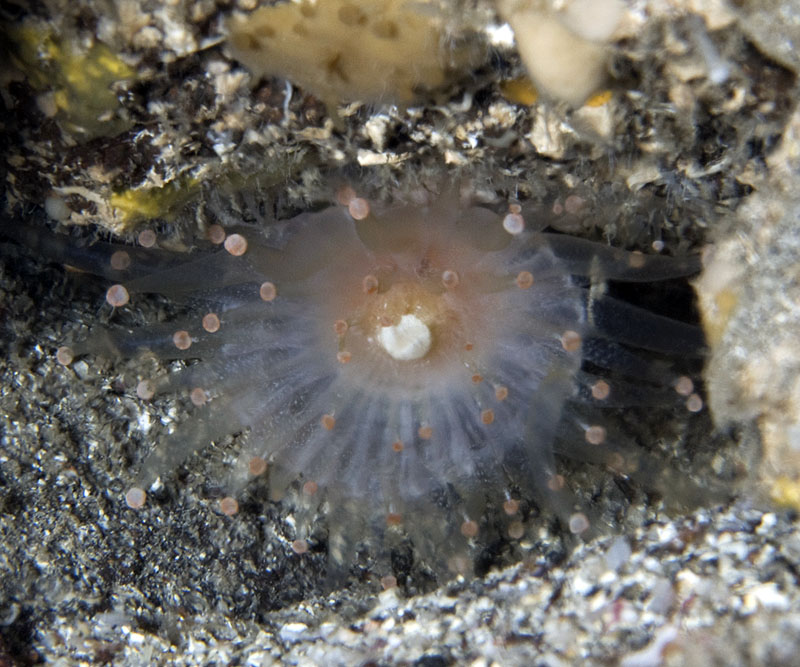 |
|
Corallimorpharian Sharon Williams photographed this anemone-like animal in a completely dark underwater cave on the South Kona coast of the Big Island in November 2012. Its disc was about 3 inches across. This was an exciting find! I sent the photo to Dr. Daphne Fautin at the University of Kansas. She replied: I would say this is not an anemone -- it is a corallimorpharian. There are occasional images of this sort of animal in all manner of places. Most of the tropical shallow photos are taken at night -- so life in a cave is perfectly compatible with it. Anyway, I would put this among the tropical, nocturnal forms of *Corynactis*. We have no idea how many species there are. Too few data. A very small and inconspicuous Corynactis species, less than half an inch across, occurs under dead coral at wading depths in Hawai`i (see Cory Pittman's photos below), but as far as I know, Sharon's photo is the first record of a large one in in the Islands. Given the difference in size, habitat, and a few other details, it would appear to be a species distinct from the small one. This animal appears to be extremely rare. If you see another one like this in Hawai`i, please let me know! Note:
In
some books, larger Corynactis like these are listed under
the genus Pseudocorynactis; according to Dr. Fautin that
genus is now considered invalid. Paul Humann and Ned DeLoach's Caribbean
invertebrate book gives the common name "Orange Ball Corallimorph"
to a similar species commonly seen in the Caribbean. |
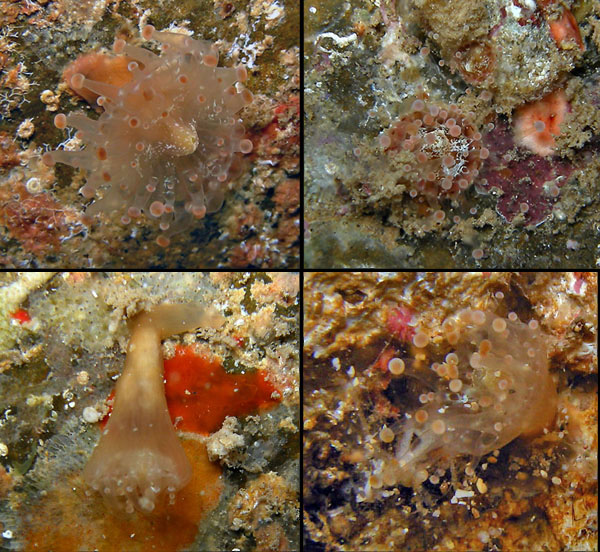 |
|
Corallimorpharian With regard
to Corynactis sp. 2, above, Cory Pittman writes: "I've
found similar animals several times under rocks at Kapalua Bay that
I've been calling Corynactis. I've attached photos of a few.
They're small and inconspicuous but apparently not uncommon at the
site. I don't know whether they're the same species as the one from
the cave..." Cory's animals are very likely the same as those
descibed from Oahu on p. 130 of Reef and Shore Fauna of Hawaii,
Section 1 (B.P. Bishop Museum Special Publication 64-1):
"This species is usually colonial, consisting of a large polyp
to which several smaller ones are connected by fleshy stolons. Large
polyps have both heights and diameters of about 10 mm. The seventy-odd
tentacles are radially arranged and bear acrospheres at the tips.
The column is orange brown; the oral disk and tentacles are mostly
transparent; and the acrospheres are opaque white to pale orange
brown." |
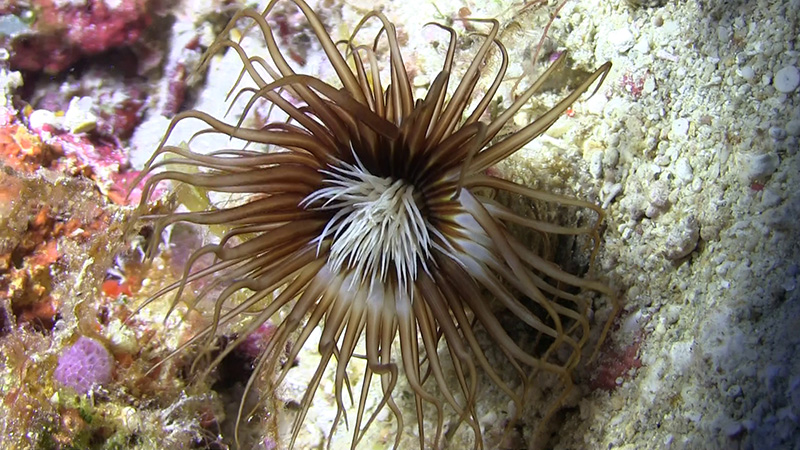 |
|
Tube
Anemone? |
|
Heteranthus verruculatus
Klunzinger,
1877 Cory Pittman
photographed a colony of these anemones in Kahului Harbor, Maui.
I sent the photo to Dr. Daphne Fautin at the University of Kansas,
who kindly identified it for us. According to Reef and Shore
Fauna of Hawaii, Section 1 (published in 1977), "The
oral disk is dark greenish brown to sepia, overlaid by varying amounts
of opaque white, the white sometimes covering all the disk except
the mesenterial insertions.... In Hawaii,
this species is known only from Coconut Island in Kaneohe Bay, Oahu,
where it occurs on sills of concrete spillways between fish ponds." |
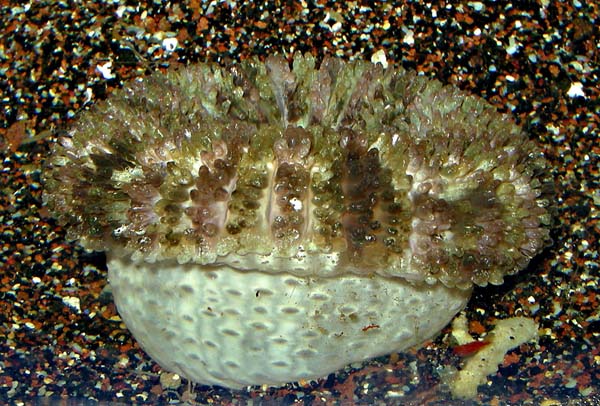 |
|
Actinoporus elongatus
Carlgren, 1900 |
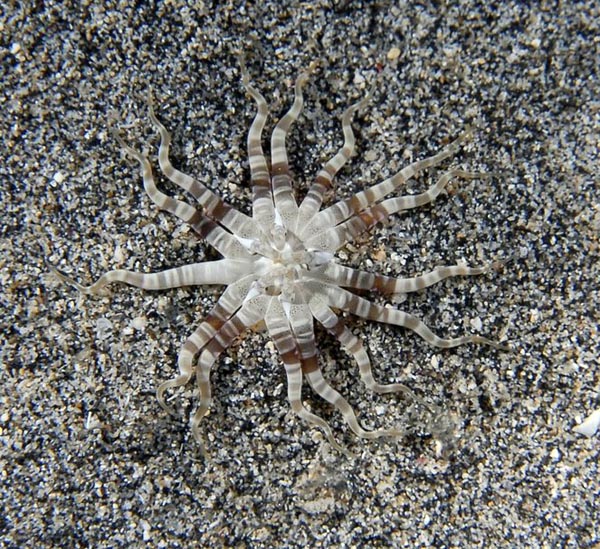 |
|
undescribed species in
genus Mesacmaea In March 2013 I received the following from Karen Sanamyan in Russia. http://actiniaria.com Today
I visited your website, a page with photos of sea anemones. I
have some comments on one species from your website (the photo is Actually
this anemone belongs to another family, this is a species of Now
about the species. Currently the genus contains only one proved
|
|
Below are four unidentified anemones I photographed in Ma`alaea Bay, Maui, in 2008. Depth was 20-30 ft. The substrate is silty sand and mud. I sent the photos to Dr. Daphne Fautin of the University of Kansas. Her brief comments below.
However, upon seeing the photos (July 2013) Roger Goodwill says he doesn't think these look like the anemone he described with Meg. |
|
|
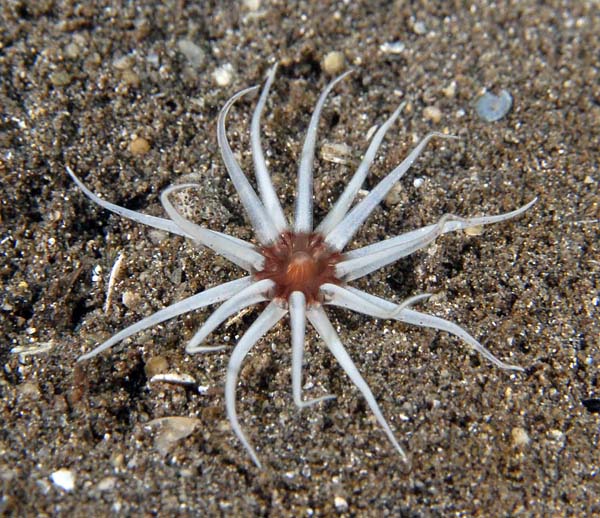 "Anemone #4, a burrower with 16 tentacles... may be an edwardsid, the group on which Meg concentrates -- and although they are nearly impossible to identify from photos, she might provide some insight." =================================================================== |
The three
photos below were taken by Cory Pittman at Hekili Point, Maui, in
April, 2013. There were several hundred anemones (largest about
7 mm across) attached to a floating plastic bin lid. We are awaiting
word from Dr. Fautin as to what they might be.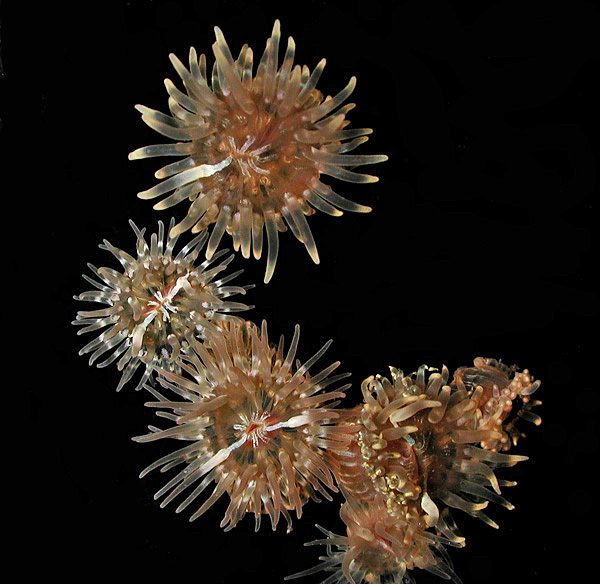
|
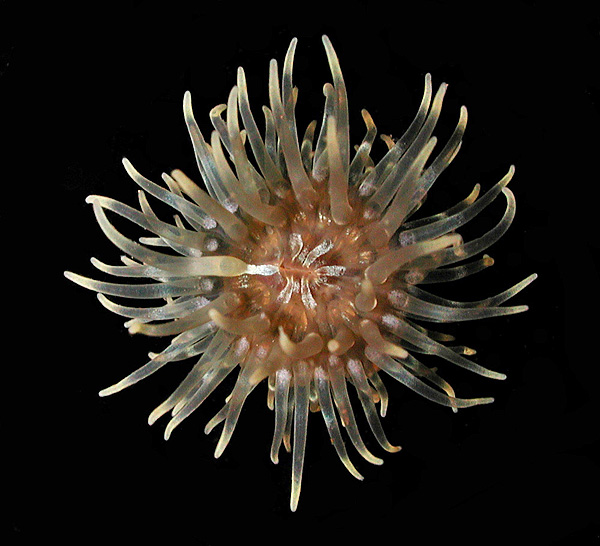 |
|
================================================================== |
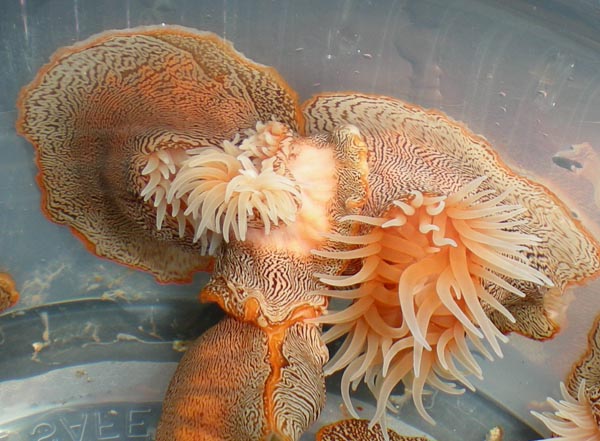 |
|
genus Nemanthus |
|
family
Aliciidae You can find still more images by searching Google. Anemones of this family, often called "Berried Anemones," are rarely reported from Hawai`i. This is a very exciting find. Go Kendra! Update: in October
2021 Kevin Roe sent me his photo of a beautiful expanded specimen
clearly showing the "berries" on its column. It was found
by his dive buddy David Fuller during a night dive in a Halimeda
bed on the south side of Maui There's no way to know whether it's
the same exact species as Kendra's find above, but it is certainly
in the family Aliciidae. |
